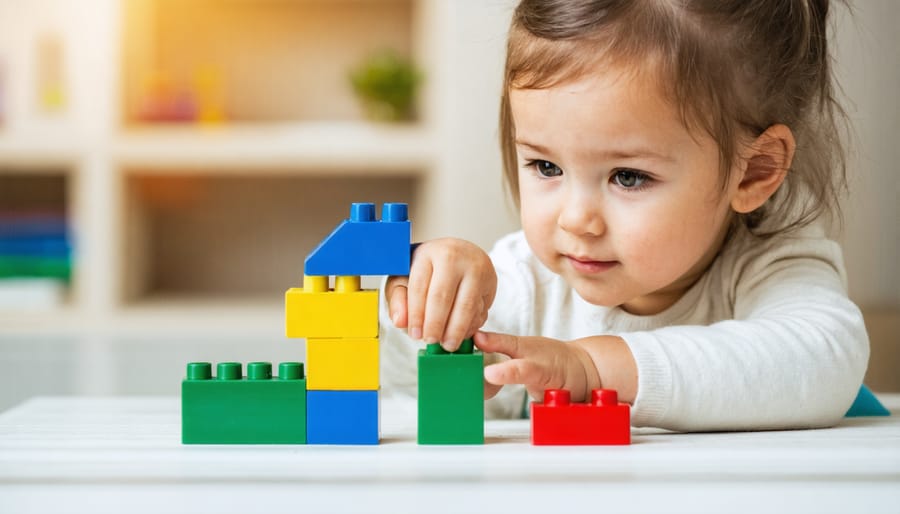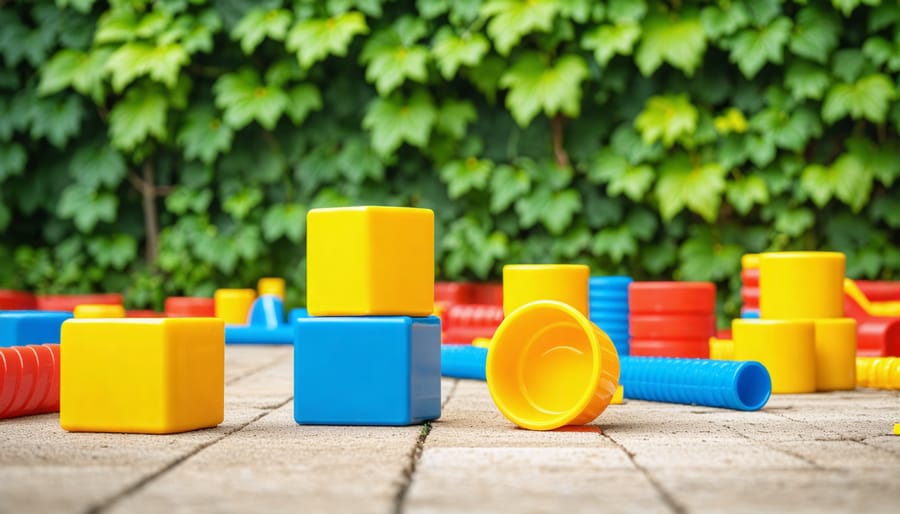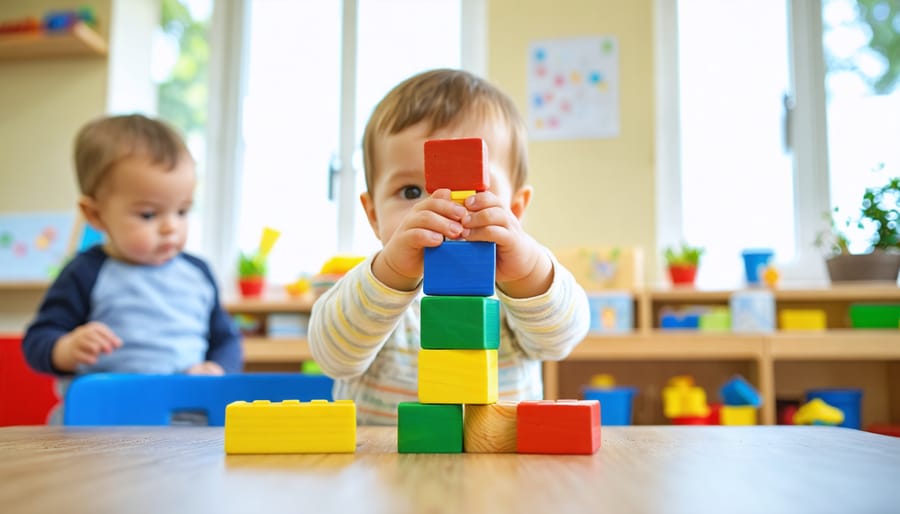Your 3-Year-Old Learns Best Through Play (Here’s How to Make It Happen)
Transform your classroom into a vibrant learning laboratory where every block tower teaches spatial reasoning, every finger painting develops fine motor skills, and every pretend-play scenario builds social-emotional intelligence. At age three, children learn best through hands-on exploration and creative play—making it the perfect time to blend education with pure joy.
**Embrace these powerful play-based approaches to maximize learning:**
Set up rotating activity stations that target multiple developmental areas simultaneously—a sensory bin for tactile exploration, a building zone for problem-solving, and a dramatic play corner for language development. Change materials weekly to maintain fresh engagement while reinforcing core concepts.
Follow your students’ natural curiosity by extending their interests into deeper learning opportunities. When a child shows fascination with trucks, create counting games with toy vehicles, build ramps to explore cause-and-effect, and introduce transportation vocabulary through stories and songs.
Keep activities open-ended and customizable to match individual learning styles and developmental stages. Provide materials that can be used multiple ways—blocks become towers, roads, or pretend food—allowing each child to explore at their own pace while building confidence and creativity.
The best part? You’re not just keeping them busy—you’re laying essential foundations for kindergarten readiness through joyful, meaningful experiences that feel like pure play.
Why 3-Year-Olds Need Play-Based Learning
If you’ve ever watched a 3-year-old at play, you’ve witnessed some serious learning in action! At this age, children are absolute powerhouses of development. They’re building language skills at lightning speed, learning to share and take turns, discovering how their bodies move, and starting to understand cause and effect. The beautiful thing? Play is exactly how they’re wired to master all these skills.
Think of play as your little learners’ natural classroom. When they stack blocks, they’re exploring physics and problem-solving. When they engage in pretend play with friends, they’re developing empathy and communication. Even simple activities like dancing or jumping are building the gross motor skills they need for more complex movements later.
Research shows us that learning through play activities aren’t just fun—they’re essential for healthy brain development. During play, children make connections between ideas, practice new skills in safe environments, and build confidence through trial and error. This is why games support learning so effectively at this age.
The best part? You don’t need fancy equipment or complicated lesson plans. Three-year-olds find wonder in cardboard boxes, water play, and dress-up clothes. Your role is simply to provide opportunities, step back, and let their natural curiosity lead the way. Trust the process—play-based learning works because it meets children exactly where they are developmentally.
Building Blocks Activities That Teach Without Feeling Like School

Simple Sorting and Stacking Games
Sorting and stacking activities are perfect for building early math skills while keeping little hands busy! Gather colorful blocks, plastic cups, or even mismatched socks for endless learning fun. Start simple by asking children to sort items by color—red blocks in one pile, blue in another. Once they’ve mastered that, introduce size sorting with nesting cups or arranging blocks from smallest to largest.
Stack challenges add excitement! Can they build a tower five blocks high? What about creating patterns like red-blue-red-blue? These activities naturally teach color recognition, size comparison, and pattern-making without feeling like traditional lessons. The best part? You can customize difficulty levels instantly. Mix in household items like plastic containers or cardboard boxes to keep things fresh and engaging. Celebrate every successful sort or stable tower—these small wins build confidence and problem-solving skills that’ll serve them well in future learning adventures!
Dramatic Play Setups That Spark Imagination
Transform your classroom into a world of possibilities with simple dramatic play setups! Create a pretend kitchen using play food, empty containers, and toy pots—three-year-olds will love “cooking” meals and taking orders. Set up a mini store with a cash register, play money, and items to “sell,” building counting and transaction skills naturally. A doctor’s office corner with bandages, toy stethoscopes, and stuffed animal patients helps children work through feelings while practicing caring behaviors.
The magic happens when children take on roles and interact with peers. They’ll naturally develop vocabulary, practice turn-taking, and learn to express themselves. Keep props simple and rotate themes weekly to maintain excitement. A post office, pet shop, or construction site each offers fresh learning opportunities. The best part? You likely have most materials already—just add your enthusiasm and watch their imaginations soar!
Movement-Based Learning Activities Your 3-Year-Old Will Ask to Repeat
Action Songs and Musical Games
Action songs bring pure joy to three-year-olds while sneaking in essential learning! Songs like “Head, Shoulders, Knees, and Toes” teach body part names and spatial awareness, while “If You’re Happy and You Know It” reinforces emotional vocabulary and following directions.
Try “The Freeze Dance” to build self-control—play music and have children dance, then freeze when the music stops. “The Hokey Pokey” introduces left and right concepts, and “Five Little Monkeys” combines counting with silly movements.
Keep songs short and repetitive so little ones can master them quickly. Add props like scarves or shakers to make movements more dramatic and engaging. The beauty of action songs is their flexibility—sing them during transitions, circle time, or whenever you need to energize or refocus your group. Plus, you can customize lyrics to match your current themes or learning goals, making these activities work harder for you!

Obstacle Courses That Build Confidence
Obstacle courses are fantastic for building both physical skills and confidence in three-year-olds! The best part? You don’t need fancy equipment—just creativity and everyday items.
**Indoor Setup:** Use painter’s tape to create lines on the floor for balancing. Add couch cushions or pillows to jump on, then set up a tunnel using chairs draped with blankets. Place stuffed animals along the route for “checkpoints” where children high-five or collect items.
**Outdoor Adventure:** Arrange hula hoops for hopping, pool noodles laid flat for stepping over, and boxes for crawling through. Use sidewalk chalk to mark paths and add simple instructions like “hop like a bunny” or “walk like a bear.”
Start simple with just 3-4 stations, then gradually add challenges as confidence grows. The key is celebrating every attempt—not perfection! Watch your little ones beam with pride as they master each section, then customize the course based on their emerging interests and abilities.
Sensory Play That Sneaks in Early Math and Science
Water and Sand Exploration
Water and sand tables are absolute goldmines for early math learning! Set up stations where your little learners can pour water between different-sized containers, discovering concepts like volume and capacity hands-on. Add measuring cups, funnels, and scoops to encourage experimentation with quantities. In the sand area, provide molds, sifters, and small buckets for comparing sizes and practicing counting. You can customize these activities by hiding numbered toys in the sand for a fun treasure hunt, or adding food coloring to water for color-mixing discoveries. The best part? Kids naturally repeat these actions over and over, reinforcing math concepts while having a blast. Keep towels nearby and embrace the mess—it’s all part of the learning adventure! These sensory-rich experiences build foundational math skills that’ll serve them well for years to come.
Texture Bins and Discovery Tables
Texture bins are absolute goldstars for sensory exploration! Fill small containers with safe materials like dry pasta, rice, cotton balls, or smooth river stones. Add scoops, cups, and small toys for your little learners to discover. These bins naturally invite children to dig, pour, and describe what they’re experiencing.
Discovery tables take this concept further by rotating themes weekly. Try a “nature table” with pinecones and leaves, or a “fabric station” with different textured cloth squares. As children explore, introduce descriptive vocabulary like “bumpy,” “smooth,” “rough,” and “soft.”
The beauty of these activities? They’re completely customizable to your classroom needs and budget. Use whatever safe materials you have on hand, and watch your three-year-olds develop fine motor skills while building their descriptive language. Plus, cleanup becomes part of the learning experience when children help sort materials back into bins!
Art Activities That Develop Pre-Writing Skills
Process Art Over Product
At three years old, children learn best through exploration and experimentation, not by creating perfect finished products. The magic happens when little hands squish paint, mix colors, or tear paper—these messy moments build fine motor skills, creativity, and confidence!
Focus on open-ended activities where there’s no “right way” to create. Set up a painting station with brushes, sponges, and fingers as tools. Let children explore watercolors, discovering how colors blend and spread. Try collage-making with torn paper, fabric scraps, and natural materials—the ripping, gluing, and arranging develop crucial hand strength and coordination.
Celebrate their process by commenting on their actions: “You’re using such gentle brush strokes!” or “Look how you mixed those colors together!” This encourages experimentation and problem-solving while building their artistic confidence.
Remember, that crumpled masterpiece represents important learning—even if it doesn’t look gallery-worthy! By valuing the creative journey over the final product, you’re nurturing resilient, curious learners who aren’t afraid to try new things.
Easy Manipulative Art Projects
These hands-on activities are perfect for building those little hand muscles while sparking creativity! Set up a paper-tearing station where kids can rip colorful construction paper into strips—no rules, just pure exploration. Safety scissors are absolute game-changers at this age; let them snip paper strips, old magazines, or even play dough “snakes.”
Play dough is your best friend for fine motor development! Encourage rolling, pinching, poking, and squishing. Add cookie cutters, plastic knives, or small toys to press into the dough for extra engagement. You can even hide small objects inside for a fun discovery activity.
Don’t forget about simple activities like stringing large beads, peeling stickers, or using chunky dot markers. These projects naturally strengthen hand coordination while keeping things playful and low-pressure. The best part? You can customize these activities based on your classroom themes or individual student interests!

Simple Game-Based Learning for Early Literacy and Numeracy
Matching and Memory Games
Matching and memory games are fantastic for building your three-year-olds’ cognitive skills while keeping them entertained! Start with simple picture cards featuring everyday objects, animals, or colors. Lay out 4-6 pairs face-down and let children flip two at a time to find matches.
You can easily customize these games based on your classroom themes or current learning objectives. Try shape matching, color sorting, or pairing upper and lowercase letters. Physical matching activities work great too—have children match real objects to picture cards, or sort toy animals into corresponding habitats.
Keep games short and celebrate every success! Three-year-olds thrive on encouragement, so make it fun with silly sounds or movement rewards when they find a match. These activities naturally develop memory, concentration, and visual discrimination skills without feeling like structured learning. The beauty is that you can adapt difficulty levels by adding more pairs as children become confident.
Counting Through Everyday Play
Transform everyday moments into counting adventures! During snack time, invite your three-year-olds to count crackers, grapes, or carrot sticks as they place them on their plates. Make cleanup time a fun counting game by challenging children to collect “five red blocks” or “three toy cars.”
At circle time, count how many friends are present or how many steps it takes to walk to the bathroom. Even transition times offer opportunities—count backward from five before switching activities or count the buttons on coats during dress-up time.
The beauty of these natural counting moments? They require zero prep and happen multiple times throughout your day. Celebrate every counting attempt with enthusiasm, whether children get the sequence perfectly or just enjoy saying numbers. You’re building number sense without worksheets, making math feel like the playful, natural part of life it should be for young learners.
Making Play-Based Learning Work in Your Classroom or Home
Creating Learning Centers on a Budget
You don’t need fancy furniture to create engaging learning centers! Start by designating specific areas in your classroom using colorful tape on the floor or simple room dividers made from cardboard boxes. A cozy reading nook works perfectly with pillows from home and a basket of board books.
Transform a small table into a sensory station with bins filled with rice, pasta, or water. Your dramatic play area? Gather donated kitchen items, old clothing for dress-up, and cardboard boxes that become anything from castles to grocery stores!
Use clear plastic bins to organize materials by activity type—blocks in one, art supplies in another. Label each center with pictures and words so your little learners know exactly where everything belongs. The beauty of play-based learning is that everyday items become incredible teaching tools. Get creative with what you already have, and watch your classroom transform into a wonderland of discovery without breaking the bank!
When to Step In and When to Step Back
The magic of play-based learning happens when you find the sweet spot between guiding and observing! Your role is to set up engaging environments, then step back and watch the learning unfold. Jump in when safety is a concern or when a child seems genuinely stuck, but resist the urge to “fix” every challenge—those problem-solving moments are golden learning opportunities.
Notice when children are deeply focused? That’s your cue to stay quiet and observe. You can enhance their play by adding materials nearby or asking open-ended questions like “What happens if…?” rather than directing their next move. If energy levels rise too high, redirect toward peaceful classroom activities that still encourage exploration.
Remember, three-year-olds thrive when they feel in control of their play. Your presence provides security, but your restraint builds confidence and creativity!
You’re doing amazing work by choosing play-based learning for your three-year-olds! Remember, every block stacked, every silly dance move, and every sensory bin exploration is genuine learning in action. These activities aren’t just keeping little ones busy—they’re building critical thinking skills, fostering creativity, and developing social-emotional intelligence in the most natural way possible.
Don’t feel overwhelmed by trying everything at once. Start with just one or two activities that excite you and match your classroom resources. Watch how your children respond—their giggles, focused concentration, and eager participation tell you everything you need to know about whether learning is happening.
The beauty of play-based learning is its flexibility. Customize activities to fit your unique group’s interests and needs. If an activity brings joy and keeps those curious minds engaged, you’ve hit the learning jackpot! Trust yourself, trust the process, and most importantly, trust that when three-year-olds are deeply engaged in play, real learning is absolutely taking place.


